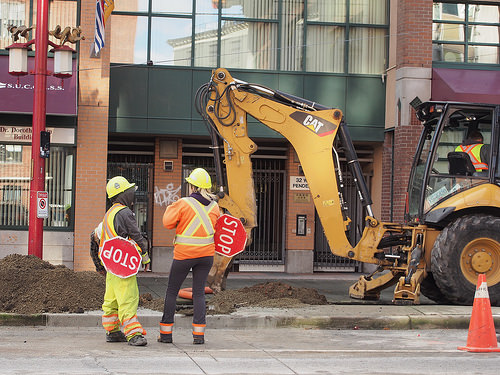The US federal Occupational Safety and Health Administration (OSHA) has reported a list of the top 10 most frequently cited standards following inspections of worksites by federal OSHA for all industries, during federal Fiscal Year (FY 2024). The remainder of this note provides OSHA’s list, with links to the standards (i.e., general industry standards) I’ve written about in other notes.
Read MoreAudit, Compliance and Risk Blog
OSHA reports on most-cited violations in fiscal year 2024
Posted by Jon Elliott on Thu, Jun 26, 2025
Tags: OSHA, Safety and Health at Work, EHSCompliance, Safety Regulations, Worker Safety, Regulatory Compliance, Health and Safety, Fall Prevention, Safety Training
The US federal Occupational Safety and Health Administration (OSHA) conducted its twelfth annual “National Safety Stand-Down to Prevent Falls in Construction” during May 5-9, 2025. The Stand-Down focused on fall hazards and fall prevention, emphasizing safety demonstrations, trainings and hazard recognition activities. Falls are a leading cause of workplace injuries and deaths in construction, and can also be important hazards in non-construction locations where workers use ladders or work in elevated locations. The remainder of this note summarizes approaches to fall hazards and fall protection.
Tags: Health & Safety, OSHA, Safety and Health at Work, workplace safety, Cal/OSHA, Injury, Safety Regulations, Worker Safety, Risk Management, Fall Prevention
Department of Labor reports fewer occupational injuries, illnesses, and deaths last year
Posted by Jon Elliott on Wed, Mar 26, 2025
The US Bureau of Labor Statistics (BLS) compiles data about occupational injuries and illnesses (I&I), and issues annual reports about occupational injuries, illnesses and fatalities. BLS cooperates with Occupational Safety and Health Administration (OSHA) requirements that employers record occupational I&I as they occur, and compile annual I&I logs to inform workers and regulators of overall rates. BLS issued its report for calendar year 2023 in December 2024, highlighting causes and distributions of workplace deaths, and noting that they were lower than in 2022. The rest of this note summarizes how these occupational incidents are reported and counted.
Read MoreTags: Health & Safety, OSHA, EHS, Safety and Health at Work, Injury, Health and Safety Compliance, Workplace Safety Guidelines, Risk Management
WorkSafeBC has amended its regulations to enhance requirements that employers in British Columbia provide first aid in their workplaces. These changes to BC’s Occupational Health and Safety (OSH) Regulation were effective November 1, 2024. The remainder of this note summarizes first aid requirements, highlighting the latest enhancements to direct requirements and to procedural requirements.
Read MoreTags: Health & Safety, Safety and Health at Work, workplace safety, Healthcare, Health and Safety Compliance, WorkSafeBC, OSH
OSHA issues safety standards for the design and use of portable powered tools and other handheld equipment items. (29 CFR 1910.242 – 1910.244). These standards focus on safe use of powered hand tools, as well as on safety features such as lock-outs and guards. The standards define general requirements for all equipment defined as powered hand tools, including specific definitions for following: explosive-actuated; fastening tools; abrasive wheels; and jacks. The remainder of this note summarizes these requirements.
Read MoreTags: Health & Safety, OSHA, Safety and Health at Work, workplace safety
New York adopts workplace violence requirements for retailers
Posted by Jon Elliott on Thu, Sep 26, 2024
On September 5, New York’s governor Kathy Hochul signed the Retail Worker Safety Act (A8947-C/S8358-C) to require employers to take steps to protect employees in retail stores from workplace violence (NY Labor Law sec. 27-e). The new law assigns the New York Department of Labor (NYDOL) to develop model policy and training documents for use by employers. Most requirements are effective as of March 4, 2025. These retail workplace violence prevention (WVP) requirements are comparable to public sector employer requirements in place since 2007 (NY Labor Law sec. 27-b), which are also administered and enforced by NYDOL. The rest of this note describes these new requirements.
Read MoreTags: Health & Safety, Workplace violence, Safety and Health at Work, workplace safety, safety violations
While the world adapts to the ongoing presence of COVID-19 and its hazards, other potential pandemic diseases continue to cause concerns. One example is avian influenza, also known as bird flu. In the US, the Centers for Disease Control and Prevention (CDC) and Occupational Safety and Health Administration (OSHA) note that avian influenza H5N1 was first seen in the U.S. in migratory birds in 2015, and in agricultural poultry stock beginning in 2022. Since then, a few mammal infections have been confirmed, and in April 2024, a dairy farm worker tested positive for avian influenza A (H5N1). This history confirms a slow expansion of pathways to infection, and at-risk species extending to include humans. There have not yet been confirmed human-to-human transmissions, which could trigger the next pandemic if they began to proliferate (just as COVID-19 did a few years ago). As these concerns rise, in August 2024 OSHA gathered and updated safety information about Bird Flu, which I summarize below.
Read MoreTags: Health & Safety, OSHA, Safety and Health at Work, workplace safety
On August 30, the Occupational Safety and Health Administration (OSHA) published its proposal to adopt a new Heat Injury and Illness Prevention Standard (29 CFR 1910.148) covering most OSHA-regulated employers. This rulemaking expands OSHA’s ongoing efforts to protect workers against heat hazards; previously, the agency has emphasized that known heat hazards trigger the Employer’s General Duty Clause (I wrote about OSHA’s National Emphasis Program for both outdoor and indoor workplaces HERE ).
Read MoreTags: Health & Safety, OSHA, Safety and Health at Work, workplace safety, Heat, Be Heat Smart
California adds heat protection rules for indoor workplaces
Posted by Jon Elliott on Wed, Aug 07, 2024
This summer has again brought record-breaking heat to parts of North America. Outdoor work in the summer sun can lead to heat illness, as can indoor work in spaces that aren’t sufficiently insulated or cooled. Since 2005, California's Division of Occupational Safety and Health (Cal/OSHA) administers detailed regulatory requirements for outdoor workplaces; other jurisdictions have since adopted similar requirements (I wrote about these HERE). Indoor workplaces have been considered, too (the federal Occupational Safety and Health Administration (OSHA) initiated a National Emphasis Program for both outdoor and indoor workplaces in 2021, which I wrote about HERE). On July 23, 2024, California adopted new requirements governing indoor workplaces (8 California Code of Regulations (CCR) 3396), which I discuss in the rest of this note.
Read MoreTags: OSHA, Safety and Health at Work, workplace safety, Heat Wave, Heat, Be Heat Smart
Federal Court confirms Superfund liability for arrangers that didn’t know their materials were hazardous
Posted by Jon Elliott on Fri, Jul 19, 2024
The federal Superfund law (Comprehensive Environmental Response, Compensation, and Liability Act (CERCLA) of 1980) defines broad categories of parties who might be deemed responsible for chemical contamination (“responsible parties”) and liable to pay for some or all the costs o cleaning up. Nearly 45 years after CERCLA was first enacted, a federal Court of Appeals has confirmed for the first time that a party that “arranges for” disposal can be liable for cleanup costs
, even if there’s no evidence that the party knew that the materials being disposed were hazardous. Although this ruling is consistent with the statutory text and decades of practice, it’s still the first formal ruling by an Appeals court (68th Street Site Work Group v. Alban Tractor Co.). The rest of this note summarizes “arranger-for” liability, and this case.
Read MoreTags: Health & Safety, EPA, Safety and Health at Work, CERCLA, Hazardous Chemicals, Hazardous Material










